Across the Earth’s northern hemisphere, many Western cultures celebrate the cooling year: fall with Halloween and Thanksgiving, the winter solstice with Christmas. The days grow shorter, the temperatures are falling, but we trust that longer days, spring and summer, will eventually return.
Return, that is, barring a nuclear winter, supervolcano eruptions, or visiting aliens constructing a Dyson shell between us and the sun. SF fans think about these things!
The following five SFF works explore worlds where spring and summer may well not return.
The Star Stealers by Edmond Hamilton (1929)
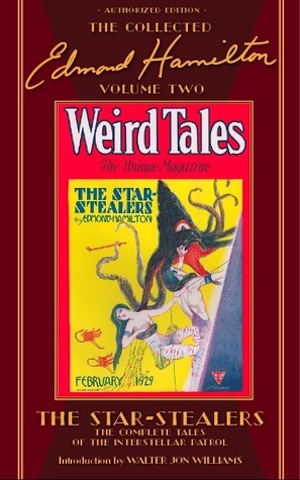
Humans are but one member race of the Federated Stars, a pan-species union of stellar nations. The Federated Stars operate an Interstellar Patrol, in which stalwart Ran Rarak is an officer. When a seemingly dead star seems set on dragging the Sun out of the galaxy, Ran and his crew investigate. The culprits? Malevolent aliens native to the dead star system, intent on appropriating our sun, regardless of the inconvenience this implies for humanity. Only the Patrol stands between the invaders and human doom!
In the aliens’ defense, they were not planning on letting us freeze. They wanted to smash the Sun’s planets into their dead star, which isn’t much better from our perspective, although the aliens thought it would be quite jolly. At least it would be quick.
Hamilton’s Interstellar Patrol series features alien species after alien species hoping to forestall impending doom in ways that would endanger the Federated Stars. Later SF series might have had their own Patrols offer the doomed aliens some way to survive without dooming other races. Not Hamilton! His Patrol never met a doomed alien civilization whose demise they were unwilling to hasten.
Have Space Suit—Will Travel by Robert A. Heinlein (1958)
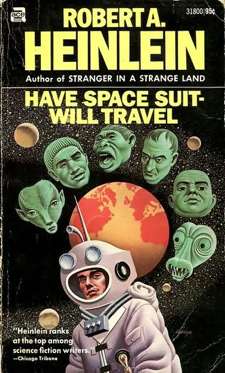
Having won second prize in a contest, Kip Russell wins not a trip to space, but a used space suit. Making the best of the situation, Kip refurbishes the suit, much as one might fix up an old jalopy. Kip’s resolute pluckiness first entangles him in an impending alien invasion from a nearby star system, then draws him (and by extension the human race) to the attention of that great civilization that dominates the Milky Way and Magellanic Clouds. The first is terrible but the second is potentially much worse: unless Kip can convince the Galactics that humanity is worth sparing, the pragmatic aliens will spare themselves possible future headaches by rotating the Earth into another universe… sans Sun. Icy doom will surely follow.
The Galactics resort to planetary genocide pretty casually, which makes me wonder just how many civilizations found themselves sunless immediately after first contact. Fortunately for humanity, the protagonist had the author on his side, so the solution the protagonist hits on (defiant yelling) turns out to be just the thing to convince the Galactics to spare us.
The Great Darkness (from Greg Stafford’s Glorantha)
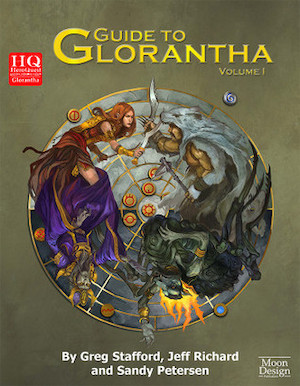
As detailed in various editions of the venerable tabletop roleplaying game RuneQuest (1978 onwards), the gods who rule the fantasy world Glorantha are a boisterous lot who are ebullient but imprudent. On occasion they have been known to inadvertently endanger the whole world. One such calamity is known as the Great Darkness, which ensued after the god Orlanth used newly invented Death to murder the sun god Yelm. Cue a sunless ice age, which ended only when Yelm was restored to life.
Being murdered and dispatched to the dark realms was certainly an inconvenience for Yelm. It was far more inconvenient for the trolls who lived in the dark realm, who were not equipped to deal with the unexpected appearance of a still luminous dead sun god in their midst.
One might expect that a fantasy world where the gods are physically verifiable reality wouldn’t have atheists. There are no atheists in Glorantha, but there are people who believe that while gods exist, they are not worthy of worship.
That seems sensible to me. Why worship entities who occasionally put the world at risk?
The World at the End of Time by Frederik Pohl (1991)
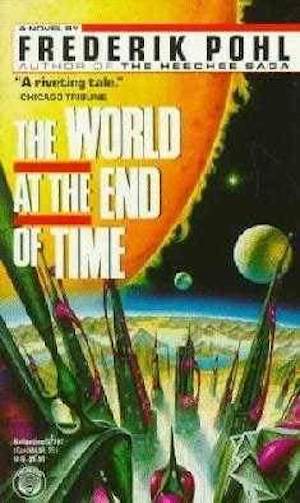
The good news for most humans is that they are not doomed to eternal darkness by the interstellar war between godlike star-dwellers. The bad news is that most of the human race is incinerated almost instantly as an insignificant side-effect of the dispute between Wan-To and the godlike alien’s offspring. Only previous attempts at human interstellar colonization preserves a tiny remnant of the human species and that, again thanks to Wan-To’s bold decisions, finds itself accelerated through time, ultimately trapped in a starless era. For the moment, one human civilization clings to life around a time-displaced brown dwarf. But only for the moment….
It is fair to say, “mistakes were made.” Readers looking for comfort reads may want to look elsewhere, as the recurring them in this Pohl novel is “And then things somehow became even worse.” And not always due to Wan-To and his children.
Mars Evacuees by Sophia McDougall (2014)

The alien Morrows saved humanity from unchecked global warming, in exchange for which they asked only for Earth’s coldest territories. These regions being too small for Morrow needs, the aliens proceeded to turn the dial on Earth’s climate way down. War ensued, one which the brave and resourceful humans have been losing at a steady pace. Humans are holding out on Mars. Protagonist and draftee Alice Dare is evacuated from Earth to Beagle Base on Mars. There her knowledge of the world will be greatly expanded, not least in the field of what it was that inspired the Morrow to flee their home system. Or perhaps “terrified the Morrow” would be more appropriate.
Among the questions addressed by the plot of this book: how quickly unattended students will go full Lord of the Flies if for some reason their adult minders were to vanish. The answer appears to be “much faster than you probably expect.” The speed at which the kids go feral raises questions about the value of their previous education.
Winter being the great enemy in many regions of the Earth, it’s no surprise there are any number of works in which winter is said to be coming, this time without subsequent respite. Feel free to enumerate the many examples I’ve overlooked in the comments, which are, as ever, below.










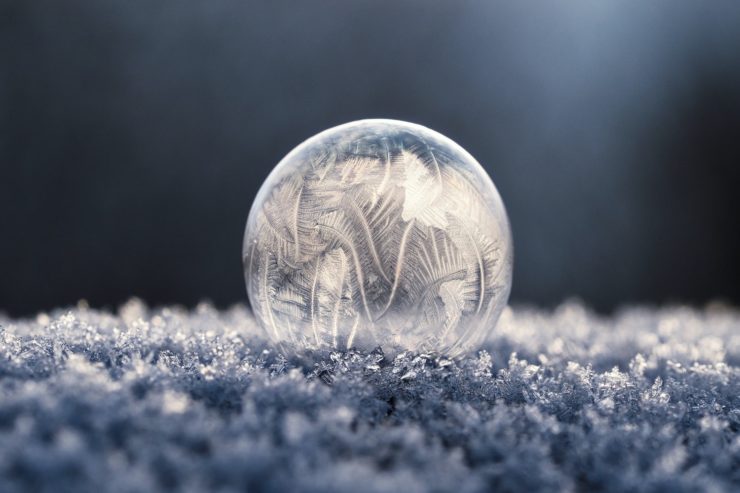

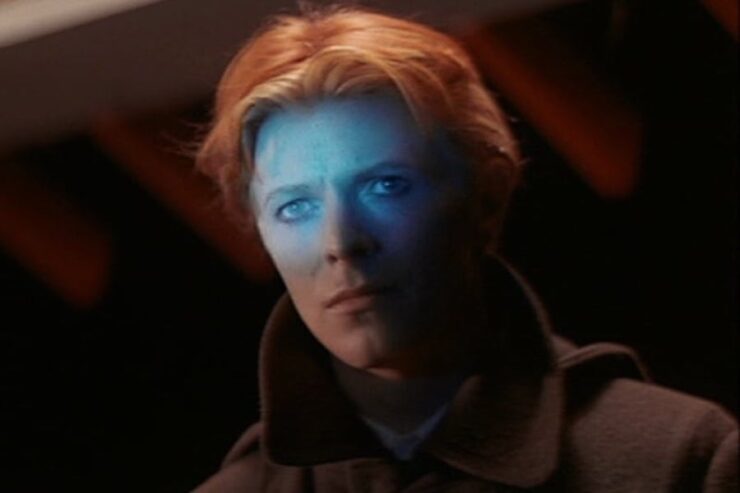

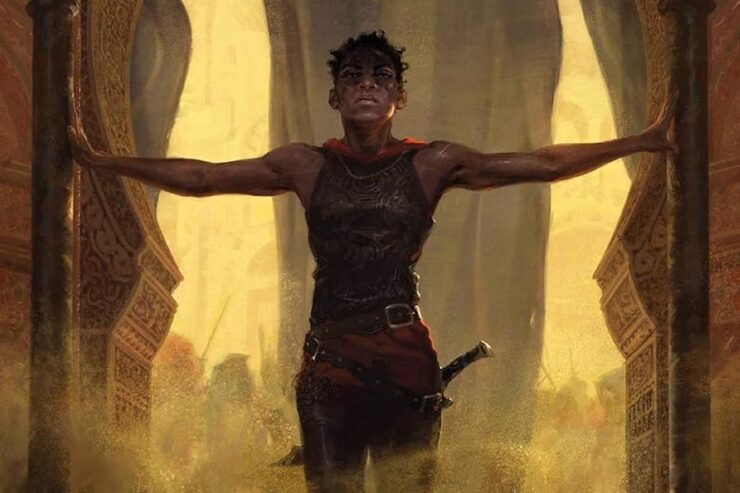
In “The Deluge Drivers” Tran Ky Ky, a planet gone Snowball Earth, is threatened with springtime
I’m not sure Kip’s defiant yelling was a factor. We get an explicit statement stating that if humanity is, or ever could be a threat to the Galactivs, they’ll do away with us immediately. We are not done away with – therefore, regardless of Kip’s speech, we must have been judged adorably harmless (unless the explicit statement was a secret test of character, which it might have been).
I always thought it was Kip’s quoting of Shakespeare that swayed the aliens.
There are the worlds already in endless winter, such as Gethen of Le Guin’s The Left Hand of Darkness.
Book of Ice series by Mark Lawrence (which I didn’t love and didn’t finish even though I enjoyed the related Book of the Ancestor series).
The Starless Crown by James Rollins (which I, also, didn’t love and, also, didn’t finish)
The flip side of gods, belief thereof and winter is in Hogfather, where the assassination attempt via getting children to stop believing in the Hogfather means the sun might not return to te world.
AndyLove @2 — If the Galactics’ statement was intended to be a test of character, I’d expect that “go ahead, we’ll come back and wipe you all out!” wouldn’t be the best response.
I always liked the plot device in Stross’s “Iron Sunrise”: simply move a star into a parallel universe, let it age normally until the end of that universe, and return a small solar-weight lump of cold iron to the place it existed. Planetary orbits are entirely unaffected! Populated planets and stations…. well, they are slightly affected.
Never-ending winters seems to be a very common theme in sf/fantasy, and on this site. I can think of many examples, but I’ll contribute just one here: “Permafrost” by Roger Zelazny.
@8: That would be bad enough, but the use of the device in Iron Sunrise was much more vicious: it just artificially aged the core of the star, causing the outer layers to fall onto it and produce a core collapse supernova (despite the star being far too small to naturally experience one).
I’m sure the portrayal of Pluto in Have Spacesuit, Will Travel is completely inaccurate (it’s more like Antarctica than the farthest “planet” from the Sun) but Kip and Oscar’s trip to activate the beacon remains one of my favourite scenes in science fiction.
Since games are a part of this conversation, there’s the very good 4X game Endless Legend, which is set on a planet beset by winters of increasing severity and length (which affect gameplay tremendously), culminating in a final winter that (one assumes) lasts forever.
Doris Lessing’s The Making of the Representative from Planet Eight describes the transformation of a temperate world into a permanently frozen one.
Just started reading `mars evacuees’ because of this post. It is delightful. And the closest to a Heinlein juvenile that I’ve read in years. (@chapter 15, but work beckons.)
@10: You’re right, I forgot that part.
Well, I know what I’m re-reading next…
Silveberg’s Time of the Great Freeze.
::Tosses Fritz Lieber’s A Pail of Air into the ring.::
First sentence: you mean winter solstice, of course.
Mars Evacuees and its sequel are great fun—too much humor to feel at all like Lord of the Flies. It’s a good choice for a book with which to hook your tween relative on SF. I am told that the physics of the space elevator is all wrong, but your favorite ten-year-old is unlikely to realize that.
@18: Yes, thanks (re: the winter solstice). In other astronomy-related news, one week ago (January 4th) today there was an interesting alignment of planets, coinciding with Earth reaching perihelion, and seven days later I’m still amused that the top comment about this reads, “Oh someone’s for sure going to awaken the old gods on that night, 100%” :)
@17 How can one consider this topic without thinking about “A Pail of Air?”
One might if one had mentioned it before and didn’t like repeating oneself.
@7: Unless the Galactics like that sort of thing (but they dropkicked the Wormfaces). I’ll stick with the first idea – humanity was assessed as harmless in spite of Kip
@11: At least Heinlein got the brightness of the Sun at Pluto right, which many people get wrong (the Sun is still very bright at Pluto’s distance).
See these pages for discussion https://larryniven.net/stone/img11.shtml and https://larryniven.net/stone/img12.shtml
“Always winter, and never Christmas.”
@21 Good point! ;-)
Any book that I read here in Fargo really. So much snow.
Poul Anderson wrote The Winter of the World, but I have no memory of it beyond that the winter was real rather than metaphorical.
In Cowper’s The Twilight of Briareus, radiation from a supernova gives Earth both female sterility and a middleweight ice age.
In Thornton Wilder’s The Skin of Our Teeth, a glacier is bearing down on the family all through Act 1 — but in Act 2 the family is in something like Atlantic City, until an end-of-the-world hurricane arrives. More meta than stfnal, but not nearly as mundane as Our Town, let alone The Merchant of Yonkers.
Michael Scott Rohan’s Winter of the World Series, in which the remnants of humanity face up against the Powers of the Ice to fend off a permanent ice age.
Notable because even in winning they lose, with their world going on to become ours – it nicely combines a lot of ancient myths into a coherent setting.
@23: Thank you. People keep forgetting the terminal F in SFF!
I was going to mention Alan Dean Foster’s Icerigger series, then realized in the very first comment The Deluge Drivers is the third in that series. I’m sure he has another iceworld, too.
It’s worth adding Kathleen O’Neal Gear’s “Rewilding Report” series to this list. While trying to fend off other problems, high technology humans plunged the world into an ice age. It might not last forever, but it has been going on for a thousand years and there is no end in sight. They also brought back the Denisovan people to try to live in that environment, our protagonists.
Doesn’t anyone here read Michael Moorcock? Remember The Silver Warriors whose paperback original had the great Frazetta cover <https://www.frazettagirls.com/products/silver-warrior-print>? Or The Ice Schooner? Or the wonderful second trilogy featuring Prince Corum: The Bull and the Spear, The Oak and the Ram, and The Sword and the Stallion?
Real world examples: the climate getting much cooler and damper in the early years of the 14th century. Leads to crop failures and famines all over Europe (plus making the Return of the Black Death more fatal than it probably would have been).
Also, the world in the early 17th century. Famines, wars, governmental collapse all over Eurasia. Fun times!
See also Cold the Night, Fast the Wolves by Meg Long. The setting is Tundar, a planet whose environment is that of Arctic-region Alaska/Canada, with only the shortest “summer.” Colonized and controlled by mining conglomerates, the planet is a source of some sort of hand-waved vital ore that’s necessary for interstellar travel. Each year, there’s a sort of Iditarod-type race allowing independent miners to stake claims, using sledges pulled by genetically-engineered wolves (apparently, something wonky in the planet’s magnetic field causes a lot of higher-tech to fry without warning, so most mining and transport is done using cruder machinery or animal power).
Pretty surprised that no one suggested GRRM’s A Song of Ice and Fire. Endless winter is what the Others/White Walkers are all about.
Already frozen, but Sol Draconi Septem in Dan Simmons’ Endymion is worth a mention. It comes complete with a high-G frozen analogue of Herbert’s Shai-Hulud, too!
Feersum Endjinn has the Encroachment which is slowly dimming the sun and cooling Earth…
It has been a long time since I read Cold Magic by Kate Elliott, but as I recall it’s set in an alternate Europe encased in an ice age. The cultural background is magical post-medieval just starting on a steampunk Industrial Revolution, with airships. There are still sabertoothed big cats around, and intelligent feathered human-sized dinosaurs (but I think they’re from North America). I honestly can’t remember if the ice age threatens to be eternal or is just shivery background, but it was an interesting world.
Serendipitously, one of the new anime out this cour is Kaina of the Great Snow Sea (created by Tsutomu Nihei), where a rapidly-freezing post-apocalyptic world is divided between the Haves (who live peaceful low-tech lives atop giant bioengineered trees) and the Have-nots (who rely on scavenged technology to eke out a short, brutal living on the glaciers below).
Only one episode is out so far, so I can’t speak to quality, but I’ve been impressed by Polygon Pictures before, even if their CG animation is a little stiff and uncanny.
No mentions for Brian Aldiss’s Helliconia books? Not just extreme winter, but seasons lasting centuries, which is very ill-adapted for human settlers, although the indigenous life-forms manage perfectly well
Anne McCaffrey and Elizabeth Ann Scarborough co-wrote the Petaybee trilogy: Powers That Be, Power Lines, and Power Play. They are set on a planet that was terraformed for colonizing, but the only land available was at the poles, so it is nearly always winter, and the colonists do not have access to much technology, so get around with dog sleds. The culture is a blend of Irish and Inuit colonists.
Wilson Tucker’s Ice and Iron was partly (mostly, actually) set in an Earth entering an ice age, and partly in a far future when the ice was in retreat.
@26 – Anderson’s The Winter of the World was set in an ice age some 11,000 years in the future, with the globe resembling what it was like (extent of continental glaciation, drop in sea level) in the Wisconsian. So there was no prospect of warming for millenia to come. There was a hint that this ice age had been triggered by a nuclear winter following a nuclear exchange in our near future.
The ruins of Chicago were mined for metals, and New Orleans was still there (under a different name).
Regarding A Pail of Air, I refuse to consider that Earth will be forever lost to eternal winter. In the spirit of rah-rah-humanity! it is only a matter of time before the remaining scientific and engineering community figures out a solution!
I’ll add the movie “The Day After Tomorrow”, which depicts Earth going into a new ice age.
While not endless, the thousands of years before the ice age is expected to end would seem endless to those experiencing it.
@28 auspex
In Alan Dean Foster’s Pip and Flinx series, we encounter Ulru-Ujurr. Its inhabitants know that an ice age is coming in several millennia so they start digging tunnels to move their world closer to their sun. Basically, they are taking action now to help save their future descendants from climate change.
(The science seems odd but according to the Humanx Commonwealth timeline, it worked.)
James Hogan’s Giants series involves (in its back story), a planet doomed to perpetual ice. Good news – they managed to avoid that fate.
I’ll mention the first non-reprint in Amazing Stories, June 1926, G. Peyton Wertenbaker’ s “The Coming of the Ice”.
Although it’s only mentioned in passing, Diane Duane’s Stealing the Elf King’s Roses is set in a series of linked parallel worlds, one of which seems to be a version of the Norse Fimbulwinter. I always wanted to know more about it…
We’re forgetting the all-time greatest:
Tugg Speedman’s Scorcher VI: Global Meltdown.
“Someone left the FRIDGE open…”
@@.-@ I was looking for a mention of Gethen and The Left Hand of Darkness. That, however, seems to be more a planet and culture defined and shaped around perpetual winter rather than threatened by it.
Which begs the question of how such a culture would react if confronted by a sudden and extreme thaw …
Niven, Pournelle, Barnes – Fallen Angels. A delightful romp through the ice age predicted in the 70s and brought on by the greens…
Iceworld (1951) by Hal Clement, what manner of creature could exist on a planet so cold that sulfur was a solid, not a gas, and water actually existed as a liquid.
Planet of Exile (1966) by Ursula K. LeGuin, winter is not permanent, but 5000 days is a long time, like in Helliconia
Century Rain (2004) by Alastair Reynolds, where Earth is rendered inhabitable, packed under an ice layer, after the technological catastrophe known as the Nanocaust.
In Karl Schroeder’s Lockstep there are a huge number of settled worlds which are either interstellar nomads or trans-Plutonian objects (e.g. Sedna) and are therefore extremely cold. The humans deal with this by only being awake one month every 30 years (remaining in cold sleep the rest of the time) and having robots maintain things and gather resources.
Not sure if the winter is neverending, but it is continuously expanding in Anna Kavan’s Ice. Unless, that is, it’s all just happening in the creepy narrator’s fantasy life.
Since the thread’s been necro’d, I’ll mention Naomi Novik’s Spinning Silver. It’s not clear that the entire world is in danger of an endless winter, but the part the protagonists live in has been having longer winters every year, which turns out to be due to frost fae stealing sunlight.